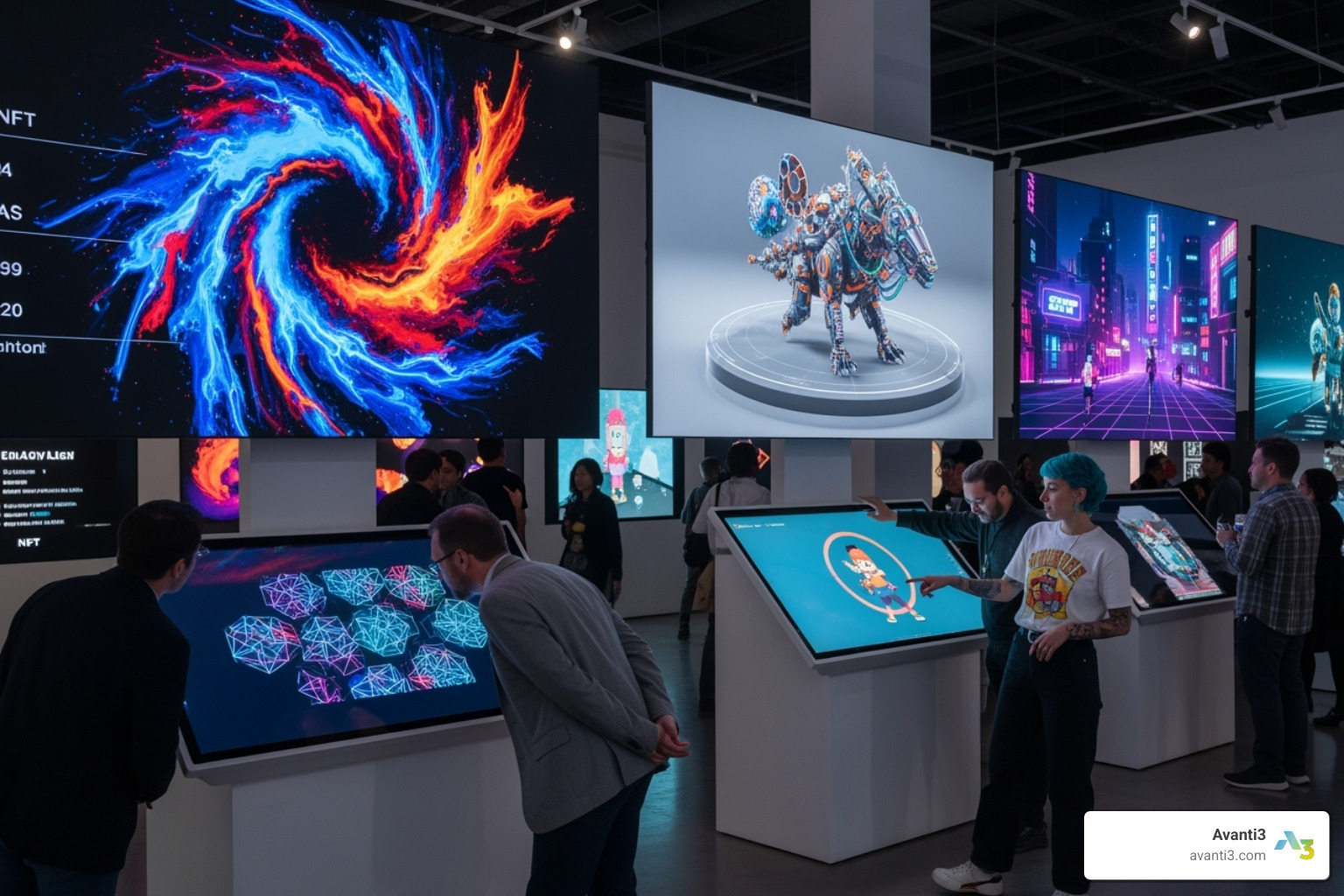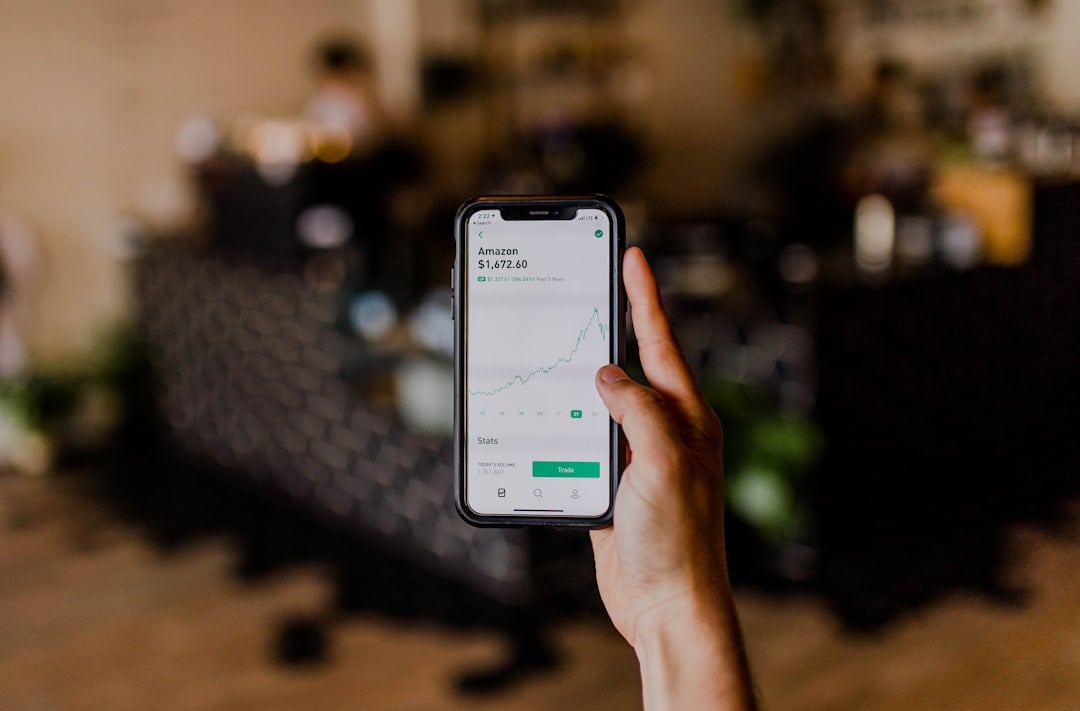Build an NFT Marketplace: Master 2025 Guide
Open uping Digital Ownership: Why Build an NFT Marketplace?
To build an NFT marketplace is to step into the future of digital ownership. These platforms are online hubs where unique digital items, like art, music, or collectibles, are bought and sold. They use blockchain technology to prove who owns what.
The world of NFTs has exploded. In 2021 alone, trading volume soared past $13 billion. That’s a massive jump from just $33 million the year before. This growth shows a huge demand for digital assets.
So, why would you want to create your own marketplace? Maybe you’re a brand or a creator tired of limits on other platforms. Building your own gives you full control. You can set your rules, shape the experience, and connect directly with your community. It’s about more than just selling; it’s about creating a unique digital space.
Here are the key steps to starting your own NFT marketplace:
- Choose a blockchain: Pick the underlying technology (like Ethereum or Solana).
- Decide market type: Will it be open (many types of NFTs) or closed (specific tokens)?
- Define your style: Design a look and feel that stands out and is easy to use.
- Set commission fees: Decide how your platform will earn money from sales.
- Build a community: Connect with buyers and sellers to make your marketplace thrive.
I’m Samir ElKamouny AV. My expertise in marketing and entrepreneurship has driven countless ventures to success, including guiding projects to build an NFT marketplace that empowers creators and connects communities.
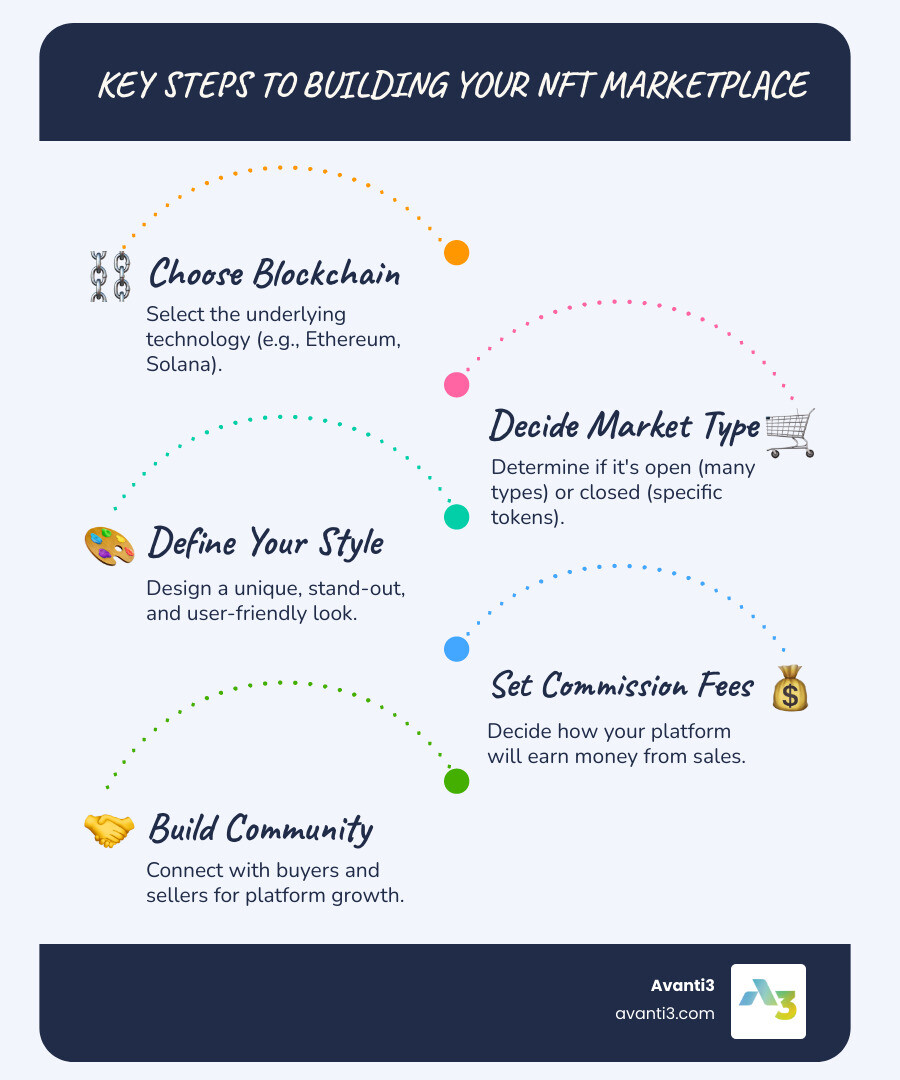
Planning Your Marketplace Foundation
When you build an NFT marketplace, planning is everything. Before you touch code, decide what you’re building and who it’s for.
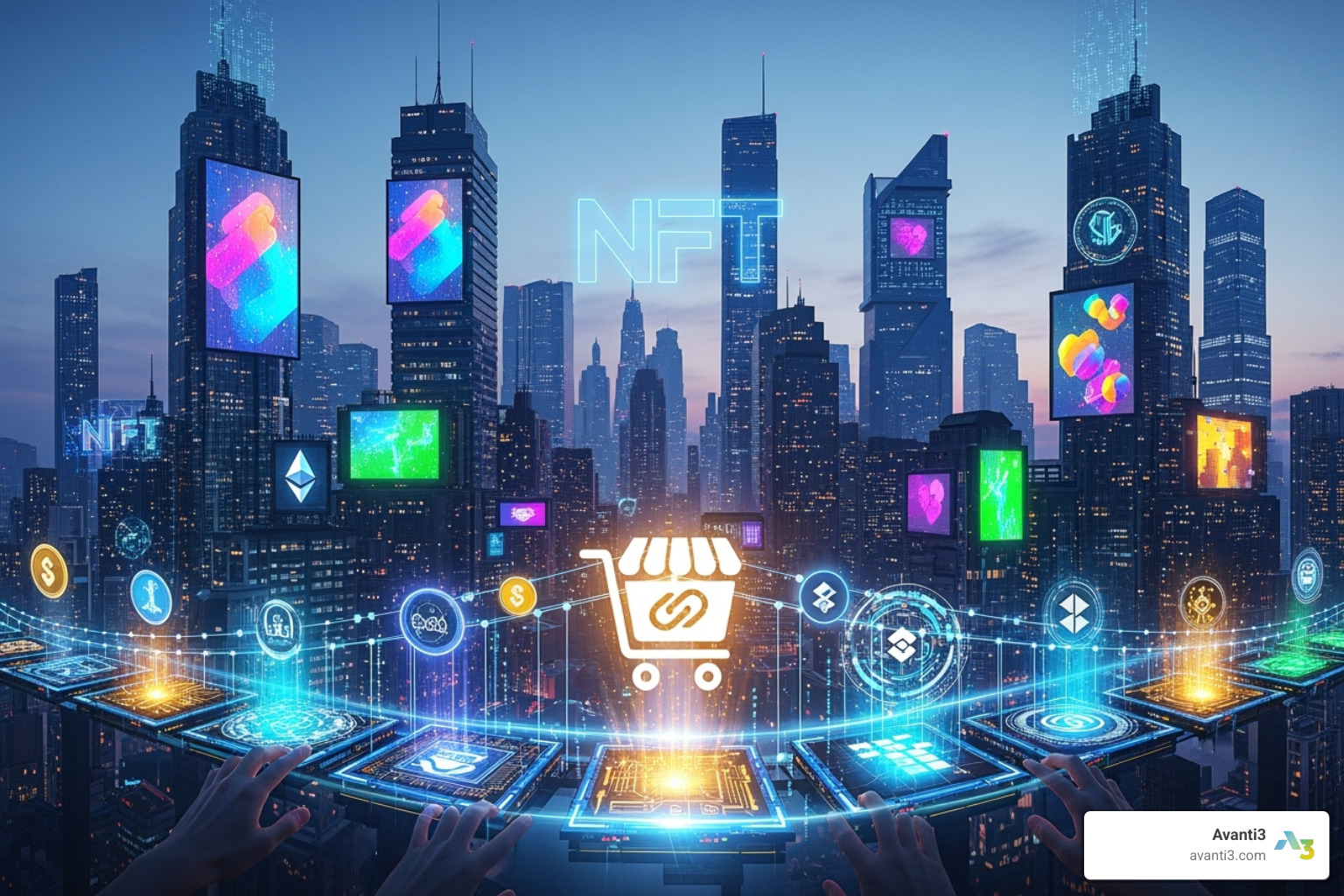
Start with your niche. Will you spotlight fine art, music collectibles, or in-game assets? That choice shapes your target audience and the features they’ll expect.
Your next move is the blockchain architecture. Custom chains are possible, but proven networks usually save time and money.
Choosing Your Blockchain
Your selection impacts speed, security, and gas fees.
- Ethereum – battle-tested and liquid, but often pricey at peak demand.
- EVM chains (Polygon, Binance Smart Chain) – Ethereum compatibility with friendlier costs.
- Non-EVM chains (Solana, Tezos, Cardano) – fast, low-fee, or eco-centric depending on the network.
Match the chain to your use-case: games benefit from Solana’s speed, prestige art may justify Ethereum’s fees. For mitigation tactics, see An overview of scaling solutions.
Defining Your Commission and Monetization Model
Clarify how the platform sustains itself:
- Commission fees on each sale (buyer, seller, or both).
- Optional listing or minting fees to discourage spam.
- Subscriptions for power users seeking lower commissions or pro analytics.
- Featured placements and other premium upsells.
Set fees that fit your audience: luxury art can sustain higher percentages, community markets often keep rates minimal.
You’re launching a living economy. Solid decisions now prevent costly pivots later.
Designing the Core Features and User Experience
After solidifying your foundation, the next crucial step in our blueprint to build an NFT marketplace is designing its interface and functionality. This is where your platform comes alive, changing technical complexity into a seamless and enjoyable experience for users.
Think of this phase as designing a digital gallery that’s also a busy marketplace. Your users need to feel comfortable browsing, confident buying, and excited to return. The best marketplaces don’t just function well – they feel intuitive, almost like the interface reads your mind.
The key is understanding your user’s journey. A collector searching for their next prized NFT has different needs than an artist uploading their first creation. Your design must accommodate both seamlessly, guiding each user naturally through their desired actions.
Must-Have Features for a Competitive Marketplace
To be functional and competitive, your NFT marketplace must include a robust set of essential features.
- Storefront: A visually appealing digital shop window that showcases NFTs and collections effectively, highlights trending assets, and encourages exploration.
- Advanced search and filters: Powerful search functionality with filters for categories, price, creators, and attributes is critical to help users find exactly what they want.
- Listing creation process: A simple, intuitive process for sellers to upload assets, add descriptions, set prices (fixed or auction), and define royalties. Support for token standards like ERC-721 and ERC-1155 is key.
- Bidding and auction system: A flexible system offering fixed-price sales, timed auctions, and open-bid auctions to cater to different user preferences and transaction types.
- Wallet connection: Seamless integration with popular crypto wallets like MetaMask and Coinbase Wallet to enable transactions. Supporting multiple cryptocurrencies adds flexibility for users.
- Ratings and reviews: A system to build trust and accountability, allowing buyers to rate sellers and provide detailed reviews to help newcomers identify reliable community members.
- User profiles: Digital identities that showcase owned NFTs, listed items, and transaction history. Seller profiles act as portfolios to build credibility.
- Transaction history: Clear, accessible records of all purchases, sales, and bids to provide transparency and build user confidence.
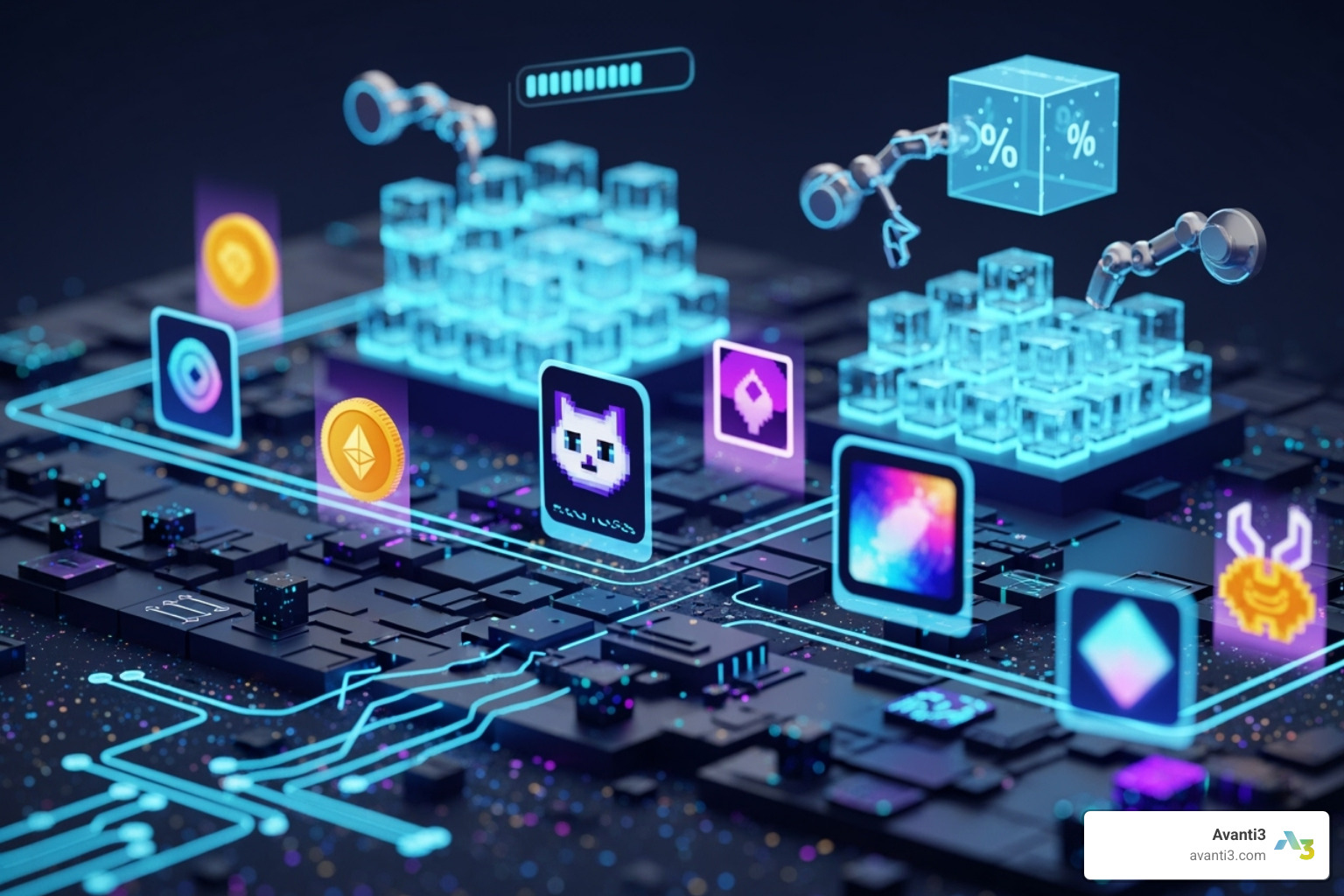
‘Nice-to-Have’ Features to Stand Out
While the essentials cover functionality, these advanced features can significantly differentiate your marketplace and create a more engaging user experience.
- Lazy minting: Allows NFTs to be listed without being minted on the blockchain until purchased. This saves creators upfront gas fees, lowering the barrier to entry.
- Price history charts: Detailed graphs showing an NFT’s past sales data and trading volume help buyers make informed decisions and transform speculation into educated choices.
- Social features: Transform your marketplace into a community by enabling following, liking, sharing, and direct messaging to foster relationships and long-term engagement.
- Community forums: Dedicated spaces, such as a Discord server or on-platform forum, for users to discuss NFTs, share knowledge, and build relationships.
- Governance tokens: Platform-specific tokens that give users voting rights on marketplace decisions, creating a sense of ownership and aligning interests with platform success.
- Multi-chain support: Expands your reach by supporting networks like Ethereum, Polygon, and Solana, giving users more flexibility and access to different communities.
- Fiat payment gateways: Dramatically expand your user base by allowing purchases with traditional currency (USD, EUR), onboarding users who are not yet comfortable with cryptocurrency.
- Additional features: Consider NFT creation tools with user-friendly templates to simplify the process for beginners, or airdrops and rewards systems to incentivize loyalty.
By blending robust core features with thoughtful improvements, you can build an NFT marketplace that isn’t just functional – it becomes a destination users genuinely enjoy visiting and using.
The Development Roadmap: How to Build an NFT Marketplace
Now comes the exciting part – turning your carefully crafted plans into reality. When you’re ready to build an NFT marketplace, you’re stepping into a world where code meets creativity, and blockchain technology transforms your vision into something tangible.
Think of this phase like constructing a house. You’ve got your blueprints (your planning), you know what it should look like (your design), and now it’s time to pour the foundation and raise the walls. The development process is where the magic happens, but it’s also where things can get pretty technical.

Most successful projects follow an agile development approach. This means building in small, manageable chunks rather than trying to create everything at once. We typically start with an MVP (Minimum Viable Product) – basically, the simplest version that actually works. This gets your marketplace up and running quickly so you can start gathering real user feedback and making improvements.
Building an NFT marketplace involves several moving parts that need to work together seamlessly. Smart contracts are the heart of your platform – these are like digital agreements that automatically handle everything from creating NFTs to processing sales. They live on the blockchain and can’t be changed once deployed, so getting them right is crucial.
The frontend development creates what your users actually see and click on. This includes connecting to crypto wallets, displaying beautiful NFT galleries, and making sure everything works smoothly on both computers and phones. Meanwhile, backend development handles all the behind-the-scenes work like user profiles, search functions, and storing data that doesn’t need to live on the expensive blockchain.
One clever solution many marketplaces use is IPFS for storage. Instead of storing large image or video files directly on the blockchain (which would cost a fortune), they store them on IPFS – a decentralized storage network. The blockchain just keeps a link to where the actual file lives.
Choosing Your Path: How to Build an NFT Marketplace From Scratch vs. Using a Solution
Here’s where you face a big decision: should you build everything from the ground up, or use an existing solution as your starting point? It’s a bit like choosing between building a custom house or buying a pre-built one and renovating it to your taste.
| Feature | Building from Scratch | Using a White-Label/PaaS Solution |
|---|---|---|
| Cost | High (estimated $39,060 – $200,000+) | Lower (saves $50K-$100K in development costs) |
| Time | Long (estimated 4-6 months+ for full-feature) | Faster (saves 2-3 months working with vendors) |
| Customization | Full control, highly customizable | Limited to platform’s capabilities, less flexible |
| Control | Complete ownership and control over all aspects | Dependent on the solution provider, less direct control |
| Technical Debt | Potential for more if not managed well | Managed by the platform provider |
| Maintenance | Requires dedicated team for ongoing updates | Handled by the solution provider (PaaS model) |
| Scalability | Designed and built for your specific needs | Relies on the solution provider’s infrastructure |
| Learning Curve | Very high, requires deep technical expertise | Lower, often no-code or low-code |
Building from scratch gives you complete freedom but requires significant time, money, and technical expertise. You’ll own every line of code and can create exactly what you envision. However, you’re also responsible for everything – security, updates, scaling, and fixing bugs at 2 AM.
Using a white-label solution is like getting a head start in a race. You can launch faster and cheaper, but you’re somewhat limited by what the platform offers. For many creators and brands just starting out, this can be the smarter choice. You can test your ideas, build your community, and learn the market without massive upfront costs.
Key Technical Skills to Build an NFT Marketplace
If you decide to go the custom route, you’ll need a team with some pretty specific skills. Building an NFT marketplace isn’t your typical website project – it requires a unique blend of traditional web development and blockchain expertise.
Solidity is the programming language that powers smart contracts on Ethereum and similar blockchains. Think of it as the specialized language your marketplace uses to talk to the blockchain. Your developers will also need solid JavaScript skills for both the user interface and server-side logic.
React.js and Node.js are popular choices for building modern, responsive websites that can handle the complex interactions an NFT marketplace requires. Ethers.js acts as the bridge between your website and the blockchain, letting users connect their wallets and make transactions.
Development frameworks like Hardhat make the whole process more manageable by providing tools for testing and deploying smart contracts. And here’s a pro tip: don’t reinvent the wheel. Secure smart contract templates from OpenZeppelin offer battle-tested, audited code that can save you months of development time and potential security headaches.
The beauty of this technical stack is that it combines the reliability of proven web technologies with the innovation of blockchain. Your team doesn’t need to be blockchain wizards from day one, but they do need to be willing to learn and adapt to this exciting new frontier.
Launch, Growth, and Governance
The journey to build an NFT marketplace doesn’t end with development. The launch, subsequent growth, and ongoing governance are equally critical for long-term success. A well-executed go-to-market strategy, robust community building, and diligent attention to legal and security considerations will define your platform’s trajectory.

Before a full public launch, we often recommend a beta testing phase. This involves inviting a select group of users to test the platform, identify bugs, and provide valuable feedback. Their insights are crucial for refining the user experience and ensuring a smooth public debut.
Building a Thriving Community
An NFT marketplace is more than just a platform; it’s a community. Engaging your users is paramount to its success.
- Dedicated Channels: Establish a strong presence on platforms like Discord and Twitter, which are native to the Web3 community. Discord, in particular, allows for direct engagement, support, and community discussions.
- Content Marketing: Share compelling stories about your creators, featured NFTs, and the vision behind your marketplace. Educational content about NFTs and blockchain can also attract new users.
- Creator Partnerships: Collaborate with influential artists and creators to bring exclusive content to your platform. Their audience can become your audience.
- Airdrops and Giveaways: Run campaigns to distribute NFTs to early adopters or loyal community members, incentivizing engagement and rewarding participation.
- Exclusive Access: Consider granting new customers or loyal users access to exclusive clubs or features within your ecosystem.
- Feedback Loops: Actively solicit and respond to user feedback. This makes your community feel valued and helps you continuously improve the platform.
Connecting with buyers and building a community is a mission that requires significant effort. It’s about fostering a sense of belonging and shared interest.
Navigating Legal and Security Considerations
Operating an NFT marketplace involves navigating a complex landscape of legal and regulatory requirements, alongside ensuring top-tier security.
- Legal and Regulatory Compliance:
- KYC/AML (Know Your Customer/Anti-Money Laundering): Depending on your jurisdiction and the nature of transactions, you may need to implement KYC/AML procedures to prevent illicit activities.
- Intellectual Property Rights: NFTs represent ownership of digital assets, but not necessarily the underlying intellectual property. Clearly define terms of service regarding IP rights, copyright, and authenticity to protect creators and buyers. Implement robust reporting mechanisms for copyright infringement.
- Jurisdiction: Be aware that NFT platforms for specific assets, like tokenized real estate, may require registration with local authorities.
- Terms of Sale: Clearly establish the terms of sale for NFTs to avoid conflicts and provide legal clarity for users.
- Security Best Practices:
- Smart Contract Audits: Before deploying, have your smart contracts rigorously audited by independent security firms. This identifies vulnerabilities like re-entrancy attacks (where malicious actors can repeatedly execute code) and ensures the integrity of your marketplace logic.
- Data Privacy: Implement strong data encryption and adhere to global data protection regulations (e.g., GDPR).
- Authorization Controls: Ensure robust user authentication and role-based access controls to prevent unauthorized access.
- Fraud Detection: Employ AI-powered fraud detection mechanisms to identify and mitigate suspicious activities.
- Secure Hosting and Domain Choices: Your hosting provider should offer high computing power, ample storage, and advanced security features (SSL/TLS, firewalls, DDoS protection, regular backups). A secure domain (HTTPS) is non-negotiable.
- Regular Updates: Keep all software, libraries, and dependencies updated to patch vulnerabilities.
Addressing these legal and security aspects proactively is crucial for building trust and ensuring the long-term viability of your NFT marketplace.
Frequently Asked Questions about Building an NFT Marketplace
I know that deciding to build an NFT marketplace can feel overwhelming. You’re probably wondering about costs, timelines, and whether it’s even profitable. Let me walk you through the most common questions I hear from entrepreneurs and creators considering this exciting venture.
How much does it cost to build an NFT marketplace?
Here’s the honest truth: the cost to build an NFT marketplace varies dramatically based on what you’re trying to create. Think of it like asking “how much does a house cost?” – it all depends on size, location, and features.
For a basic MVP (Minimum Viable Product), you’re looking at around $39,060 to get started. This covers the essentials: a clean UI/UX design (about 130 hours of work), core app development (around 578 hours), thorough QA testing (200 hours), and project management to keep everything on track.
But if you’re dreaming bigger – maybe you want multi-chain support, advanced auction systems, and custom integrations – prepare for costs between $150,000 to $200,000 or more. I’ve seen some premium marketplaces cost even more when they include cutting-edge features.
Several factors will push your costs up or down. Custom, sophisticated design costs more than using templates, but it also makes your platform stand out. Supporting multiple blockchains like Ethereum, Polygon, and Solana adds complexity but gives users more options. Complex smart contracts for things like automated royalties or unique auction mechanics require more development time.
Don’t forget about ongoing maintenance costs either. Plan for about 15-20% of your initial development cost each year for updates, security patches, and server hosting. It’s like maintaining a car – regular upkeep keeps everything running smoothly.
How long does it take to develop an NFT marketplace?
Time is often just as important as money when you’re eager to launch. The good news? You can get a basic MVP live in 3 to 4 months if you stay focused on core features.
For a full-featured platform with all the bells and whistles, expect 4 to 6 months or longer. I always tell clients that rushing this process usually backfires – it’s better to launch something solid than something broken.
Here’s how the timeline typically breaks down. Planning and research takes 2-4 weeks (trust me, this time is worth it). UI/UX design needs 4-6 weeks to get right. Smart contract development is crucial and takes 6-10 weeks. Frontend and backend development is the longest phase at 8-16 weeks. Testing and security auditing requires 4-6 weeks – never skip this step. Finally, deployment and launch takes 1-2 weeks.
The timeline can stretch or shrink based on your team size, how quickly decisions get made, and how complex your feature set is. Using a white-label solution can save you 2-3 months compared to building everything from scratch.
How do NFT marketplaces make money?
This is probably the most important question – after all, you want your marketplace to be profitable, not just functional.
Commission fees are the bread and butter of most NFT marketplaces. You take a small percentage of each sale, typically ranging from 1% to 5.25%. Some platforms charge the buyer, others charge the seller, and some charge both. The key is finding a balance that doesn’t scare away users but still generates meaningful revenue.
Listing and minting fees provide another revenue stream. You might charge creators a small fee to list their NFTs or to mint new ones directly on your platform. Keep these reasonable – you want to encourage activity, not discourage it.
Premium features can be surprisingly profitable. Think featured listings where creators pay for prime placement, advanced analytics for serious traders, or advertising space for relevant brands. These services add value while generating extra income.
Some innovative marketplaces issue governance tokens that users can buy, trade, and use to vote on platform decisions. This creates additional revenue opportunities through tokenomics while building community engagement.
The profitability ultimately depends on your trading volume, fee structure, and how well you retain users. A marketplace with loyal, active users will always outperform one with high traffic but low engagement.
At Avanti3, we understand that building a successful NFT marketplace requires more than just technical expertise – it needs strategic thinking about monetization, community building, and long-term sustainability. That’s why we help brands create comprehensive Web3 engagement platforms that go beyond simple buying and selling.
Conclusion
Taking on the journey to build an NFT marketplace might feel overwhelming at first, but it’s also incredibly exciting. Think of it as creating your own digital world where creators and collectors can connect, trade, and build communities around the things they love.
We’ve covered a lot of ground together. We started with choosing the right blockchain foundation and figuring out how your marketplace will make money. Then we dove into creating user experiences that people actually enjoy using. Finally, we tackled the technical side of development and the ongoing work of building a thriving community.
The digital ownership landscape is changing fast, and NFT marketplaces are leading the charge. They’re giving creators new ways to connect directly with their fans and build sustainable businesses. For brands, they offer fresh opportunities to engage customers in meaningful ways.
The future looks bright for digital ownership. We’re seeing more integration with real-world assets, better user experiences, and innovative ways to combine NFTs with other technologies. When you build an NFT marketplace, you’re not just creating a platform – you’re helping shape how people think about owning digital items.
At Avanti3, we live and breathe this stuff. We specialize in bringing together Web3 technologies like NFTs, blockchain, AR/VR, and AI to create engagement tools that actually work. Our focus is on helping creators and brands build genuine connections with their communities through unique digital experiences, smart rewards systems, and tools that bring people together.
The path to build an NFT marketplace is challenging, but it’s also full of possibilities. Whether you’re starting with an MVP or dreaming of a full-featured platform, every successful marketplace started with someone taking that first step.
Ready to turn your vision into reality? Build your custom Web3 engagement platform and join the digital ownership revolution.

